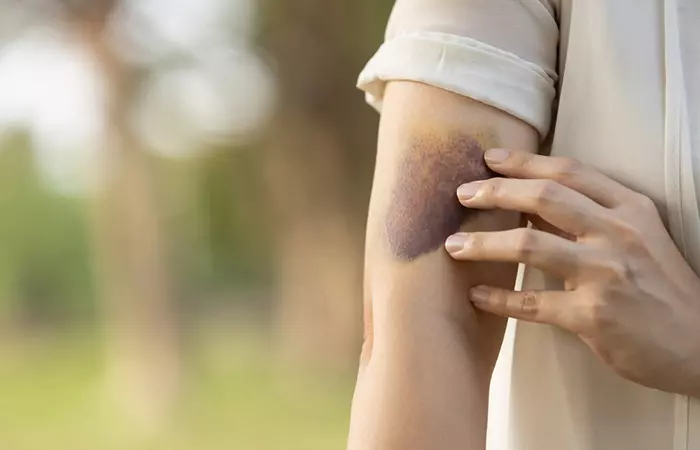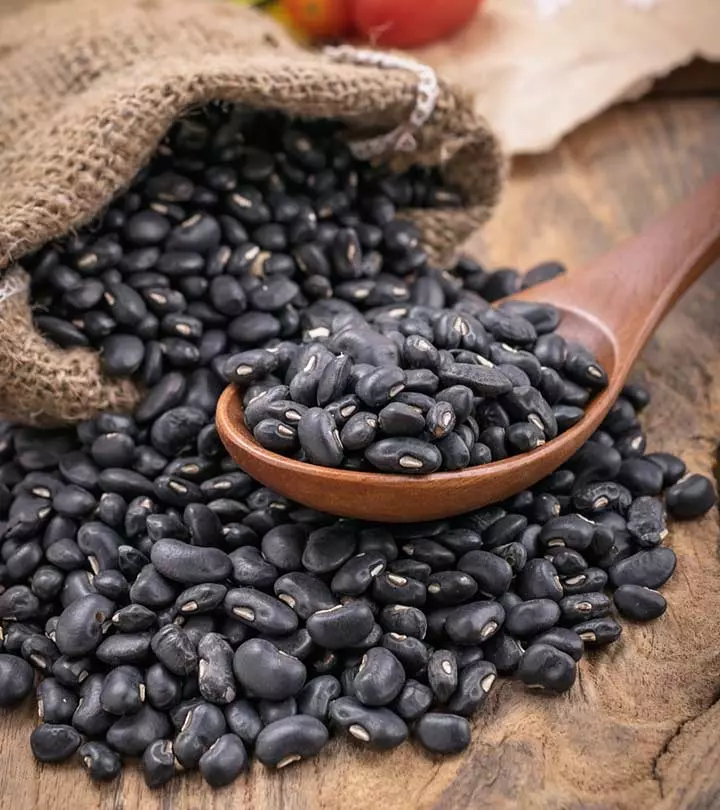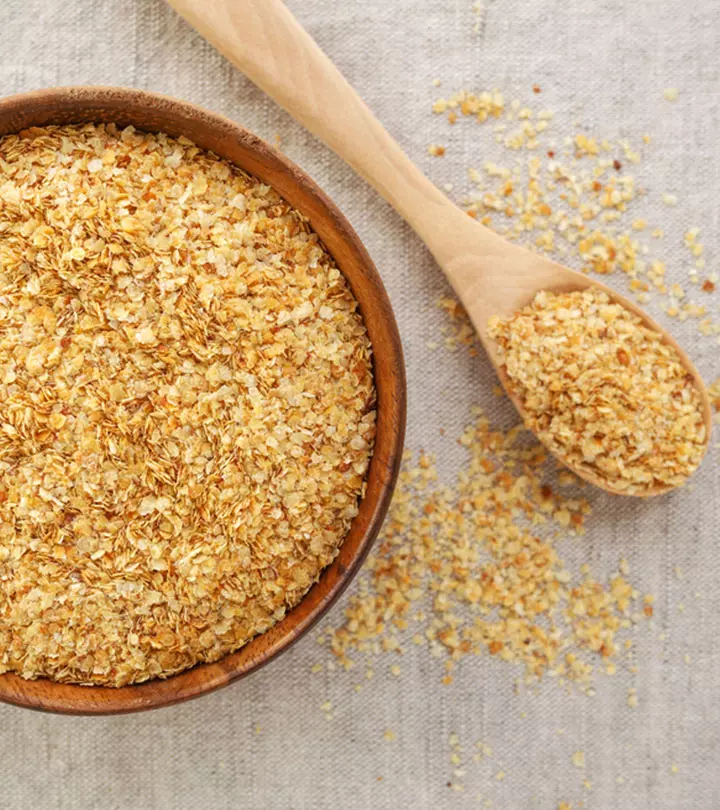4 Benefits Of Arnica, How To Use It, Dosage, & Side Effects
Everything you need to know before using this shrub to improve skin, hair, and health

Image: Shutterstock
Arnica montana, popularly known as arnica, is widely used as homeopathic medicine. This perennial shrub is native to Europe. Arnica’s benefits majorly include pain relief and combating inflammation.
Also, it is used to treat inflamed tissues, arthritis, bruises, scars, and postoperative muscle soreness (when used in the form of diluted preparations). It is generally used either as gel or oil.
In this article, you can find the research-backed benefits of arnica and its dosage. You can also take a look at the potential negative effects of its use. Continue reading to know more.
 Know Your Ingredient: Arnica
Know Your Ingredient: ArnicaWhat Is It?
Arnica Montana is a perennial shrub that is native to Europe and is widely used in homeopathic medicine.
What Are Its Benefits?
Arnica has pain-relieving properties so it is used in managing arthritis and may help in healing scars and bruises.
Who Can Consume It?
It is safe for everyone for consumption and topical application except pregnant or breastfeeding women.
How Often?
It is safe to apply arnica for a short term or consume it daily or as prescribed.
Caution
Avoid applying it on broken skin such as leg ulcers and if you are allergic to the herb.
In This Article
Arnica: In Detail
Arnica montana is a perennial shrub native to Europe. It is also known as Leopard’s Bane, Wolf’s bane, Mountain Tobacco, and Mountain Snuff. This Asteraceae member has bright yellow, July-blooming, happy flowers and is a homeopathy staple.
Arnica has pain-relieving and anti-inflammatory properties. It has been used to treat epilepsy, seasickness, wounds, and gunshots in the 20th century. In Europe, Arnica was thought to possess fungicidal and bactericidal properties (1). You can, thus, find Arnica in many homeopathic ointments, gels, tinctures, creams, and tablets.
The active compounds in this plant, especially sesquiterpene lactones, are responsible for various medicinal applications (1). These sesquiterpenes occur in varying amounts in the plant parts. The concentration of sesquiterpenes was found to be higher in the disc florets than in the ray florets and even lower in the stalk.
Such variability in the bioavailability of active compounds might influence the efficacy of Arnica. However, the mechanism of Arnica’s action has not been studied extensively. It also has received a lot of flak for being poisonous.
And that’s when the physicians understood the power of its dosage. Arnica is known to be highly beneficial for your health, but only in trace amounts.
 Trivia
TriviaThis is why it is important to understand its benefits. Read on!
Key Takeaways
- Arnica may provide relief from pain, inflammation, swelling, and hair thinning.
- Its helenalin compound may protect against certain types of cancers.
- Common side effects include skin allergies, interference with medications, and elevated heart rate.
- Lactating women should use arnica with caution.
What Are The 4 Main Benefits Of Using Arnica?
1. May Relieve Pain And Inflammation

In homeopathy, arnica is used to control swelling, edema, pain, and inflammation in tissues. It showed comparable results to allopathic anti-inflammatory drugs, such as diclofenac and ibuprofen (2).
Topical use of arnica ointments and gels may help relieve acute muscle pains, sprains, strains, tendonitisi It is the irritation or inflammation of a tendon, the connective tissue that links muscles to bones. , stiffness, fibromyalgiai A common disease that causes pervasive tenderness and pain in the muscles and joints. , etc. (2).
Its clinical efficacy in relieving pain and inflammation makes it a potential alternative to non-steroidal anti-inflammatory drugs (2).
There is limited yet convincing scientific evidence proving the positive effects of Arnica on cellulitisi A typical bacterial skin infection that results in pain, swelling, and redness in the affected area. -derived pain, numbness, acute back pain, headache, hemorrhoidsi Also referred to as piles, they are inflamed and swollen veins in the lower region of the anus and rectum. , etc. (3),(4).
When administered with other oral homeopathic dilutions, Arnica also reduced postoperative pain in patients (2). Anecdotal evidence suggests that Arnica can also be used to treat sore throat and mouth, and insect bites.
2. May Help Manage Osteoarthritis And Rheumatoid Arthritis
Osteoarthritis (OA) is a disease that affects the joints in your knees, hips, and hands. When joints lose cartilage, usually, the bone grows to repair the damage. Osteoarthritis arises when instead of rebuilding, the bone grows abnormally and affects the routine physical function (5).
A study on 174 people with hand osteoarthritis showed that applying arnica extract gel gave comparable results with that of ibuprofen treatment. Though adverse effects were reported, this herbal treatment improved pain and function (5).
A few patients recorded better movement and recovery than the non-steroidal inflammatory drug (NSAID) counterpart. This proves that arnica oil/tincture/gel is no less than ibuprofen. They can be used similarly under medical guidance to treat chronic osteoarthritis (6).
3. Could Heal Scars And Bruises

Post-operative scars and bruises can affect an individual’s confidence and personality. Such bruises and contusions are formed when blood leaks out of damaged blood vessel walls.
The leaked blood collects around the wound or incision and obstructs the natural blood flow. Due to lack of enough oxygen supply, these injured sites turn blue, brown, green, or black, giving rise to ‘ecchymosis.’
In a study involving rhinoplasty surgeries of the nasal bone, patients were given an oral perioperative dose of arnica. These patients had accelerated post-operative healing, rapid recovery of the ecchymosisi Also referred to as a bruise, it is a skin discoloration that results from the ruptured blood vessels under the skin. , and quicker change in bruise colors to normalcy (7).
These reproducible observations prove the efficiency of Arnica in healing acne scars and bruises. Its formulations might be employed in face-lift and rhinoplasty surgeries and in deep wound healing (7), (8).
4. Might Help Cope With Hair Loss
Alopecia or severe hair loss in women can cause depression and loss of confidence. Aromatherapy or topically using arnica oil for hair may help deal with such severe hair loss. The treatment involves highly concentrated extracts that are derived from various herbs, including arnica (9).
Applying these extracts topically may also stimulate hair follicles and help in hair growth. It could also be the safest way to cope with different types of hair loss (9).
Currently, a few benefits of arnica have been studied. Arnica could be available in different forms, and in the following section, we will discuss how you can use the herb.
How To Use Arnica?

Proponents claim that both topical and ingested arnica can help. The herb is available in the following forms:
- Lotion
- Gel
- Tissue salts
- Pills
- Pain patches
- Teas
You can purchase arnica at the nearest health store or online.
The benefits above could be attributed to the active components in arnica.
What Are The Active Components Of Arnica?
Sesquiterpene-lactones, flavonoids, and phenolic acids are the classes contributing the most to Arnica’s properties.
While sesquiterpene-lactones impart anti-inflammatory and analgesic effects, the flavonoids and phenolic acids impart antioxidant and antimicrobial effects to this flower (10).
Helenalin and its esters are the types of sesquiterpene-lactones found abundantly in Arnica flowerheads. Quercetin-glucoside, patuletin-glucoside, Kaempferol-glucoside, Kaempferol-glucuronide, 6-Methoxykaempferol-glucoside, and Hispidulin are the flavonoids (10).
Chlorogenic acid, 3,5-Dicaffeoylquinic acid, 1-Methoxy-oxaloyl-3,5-dicaffeoylquinic acid, and 4,5-Dicaffeoylquinic acid are a few phenolic acids you can find in this herb (10).
Apart from the components, it also is important that we know the mechanism of the herb.
How Does Arnica Work?
There are a few proposed mechanisms through which arnica operates. They involve the inhibition of pro-inflammatory cytokines (interleukin-1, TNF-α) and the translocation of NF-ϰß and NF-AT (Nuclear Factor of Activated T-cells). NF-ϰß and NF-AT are cellular chemicals engaged in the inflammatory processes (10).
Helenalin suppresses the translocation of NF-AT in the specialized immune system cells (T cells). This is how arnica gets its immunosuppressive properties (10).
A few mice studies indicated that arnica treatment showed a 4.5-fold inhibition of nitric oxide production and a drop in the levels of nitric oxide synthase and cyclooxygenase-2 enzymes. All of these are clear signs of receding inflammation in the body (2).
However, helenalin is selectively cytotoxic. Studies show how this property of helenalin can be applied to manage cancers at the molecular level (10).
However, the cytotoxicity of arnica could be one concern. The herb may have certain side effects, which we will explore in the following section.
What Are The Side Effects Of Arnica?

Arnica is considered safe when used topically for short-term use on unbroken skin. But the US FDA has not considered it safe for oral consumption.
Some of the side effects of arnica include the following.
- May Cause Skin Allergies
Using large quantities or frequent doses of Arnica extracts might cause skin irritation. Dermatitis, eczema, allergies, and related symptoms have been reported if it is used on sensitive, damaged, and broken skin (11).
- May Accelerate Heart Rate
Ingestion of products containing arnica was found to accelerate heart rate in individuals (12).
- May Cause Gastroenteritis
Taking this oral medication in excess might cause gastroenteritis (12).
- Pregnancy And Breastfeeding
The evidence is inconclusive and insufficient to prove the safety of arnica for pregnant and lactating women.
 Did You Know?
Did You Know?Does Arnica Interact With Medications?

Arnica contains coumarins, which are compounds with anticoagulant effects. The herb may reduce coagulation and increase the risk of bleeding (13).
Hence, use it cautiously under medical supervision. Also, keep the following points in mind:
- The strength of homeopathic formulas used topically is 2 g of the flowerheads in 100 mL of water.
- Ointments might have a maximum of 20-25% of the arnica tincture.
This tincture is usually a 1:10 dilution, and the oil is usually made with 1 part of the herb extract and 5 parts of vegetable oil.
Arnica In Homeopathic Preparations
Homeopathic medicines are formulated by diluting minute amounts of the active component to the point where it is no longer identifiable. The majority of homeopathic arnica is available in pill, tincture, capsule, or dissolvable pellet form. Usually, homeopathic medicines are made in high potencies and do not cause harm (14). While there are several claims against the safety of this ingredient, the amount of arnica used in most homeopathic medicines is almost nonexistent (15). The oral homeopathic arnica is usually diluted 30 times or more. Therefore, it is considered a safe and effective homeopathic preparation due to its high dilution.
What Is The Ideal Dosage For Arnica?
Arnica is considered safe when used topically for short-term use on unbroken skin. If you are ingesting the tablets, Arnica 200c (for adults or children over 2 years of age), you may take three of them, 4 to 6 times in a day (16).
There is little information on the dosage of the gel, and you need to consult your doctor. Arnica gel or ointment is generally used topically on the affected area two to three times per day. However, it is important that you seek medical advice and use them as prescribed to prevent negative reactions.
Infographic: Herbs With Similar Uses As Arnica
Arnica is a perennial herb with a similar appearance to that of a daisy flower. It has been used for treating joint pains and bruises. However, there are some herbs with similar uses as arnica. Check out the infographic below to know more about them. Illustration: StyleCraze Design Team
Arnica is a perennial shrub known widely as a homeopathic medicine. With its pain-relieving and anti-inflammatory properties, it is found effective in treating muscle sprains, spasms, headache, back pain, menstrual pain, etc. Rich in active phenolic compounds, Arnica benefits your hair health as well. Arnica is available as gels, pills, patches, and lotions. In spite of its potential health benefits, it should only be taken as per the prescribed dosage since drug interactions and skin allergies could be some of its possible side effects.
Frequently Asked Questions
Can you use arnica every day?
Topical arnica can be used daily for up to 3 weeks or as prescribed. Oral arnica can be toxic when consumed in excess and over-prescribed. Therefore, it is recommended to not self-medicate arnica and take it as prescribed.
How quickly does arnica work?
Arnica may help heal a wound within 2 days. However, how quickly it works varies, depending on individual physiology, nature, and severity of the wound and the prescribed dosage.
Does arnica raise blood pressure?
Yes, arnica may raise blood pressure and should be avoided by individuals who take blood pressure medications or have a history of hypertension.
Is arnica good for nerve pain?
Arnica may be prescribed in small doses for nerve pain like sciatica, depending on the discretion of a healthcare provider. However, there is insufficient research into the efficacy and safety of arnica use for treating different kinds of nerve pain.
Does arnica help with black eye?
Yes, anecdotal evidence suggests that topically applied arnica may help with black eye.
Can arnica be used for psoriasis?
Yes, arnica has been used for centuries in psoriasis herbal preparations as it soothes dry, itchy skin and even irritated skin from sunburn due to its anti-inflammatory properties (17).
Illustration: Benefits Of Arnica How To Use It Dosage & Side Effects

Image: Stable Diffusion/StyleCraze Design Team
References
Articles on StyleCraze are backed by verified information from peer-reviewed and academic research papers, reputed organizations, research institutions, and medical associations to ensure accuracy and relevance. Read our editorial policy to learn more.
- Arnica montana L. – a plant of healing: review, Journal of Pharmacy and Pharmacology, Wiley Online Library.
https://onlinelibrary.wiley.com/doi/full/10.1111/jphp.12724 - Effectiveness and Safety of Arnica montana in Post-Surgical Setting, Pain and Inflammation, American Journal of Therapeutics, Academia.
https://www.academia.edu/11356581/Effectiveness_and_Safety_of_Arnica_montana_in_Post-Surgical_Setting_Pain_and_Inflammation - A Homeopathic Arnica Patch for the Relief of Cellulitis-derived Pain and Numbness in the Hand, Global Advances in Health and Medicine, US National Library of Medicine, National Institutes of Health.
https://www.ncbi.nlm.nih.gov/pmc/articles/PMC3833497/ - Enlarged hemorrhoids: How can you relieve the symptoms yourself?, InformedHealth, National Center for Biotechnology Information.
https://www.ncbi.nlm.nih.gov/books/NBK279466/ - Topical herbal therapies for treating osteoarthritis, Cochrane Database of Systematic Reviews, US National Library of Medicine, National Institutes of Health.
https://www.ncbi.nlm.nih.gov/pmc/articles/PMC4105203/ - Choosing between NSAID and arnica for topical treatment of hand osteoarthritis in a randomised, double-blind study, Rheumatology International, US National Library of Medicine, National Institutes of Health.
https://pubmed.ncbi.nlm.nih.gov/17318618/ - Perioperative Arnica montana for Reduction of Ecchymosis in Rhinoplasty Surgery, Annals of Plastic Surgery, US National Library of Medicine, National Institutes of Health.
https://pubmed.ncbi.nlm.nih.gov/25954844/ - Effect of homeopathic Arnica montana on bruising in face-lifts: results of a randomized, double-blind, placebo-controlled clinical trial, Archives of Facial Plastic Surgery, US National Library of Medicine, National Institutes of Health.
https://pubmed.ncbi.nlm.nih.gov/16415448/ - ALOPECIA: HERBAL REMEDIES, International Journal of Pharmaceutical Sciences and Research.
http://citeseerx.ist.psu.edu/viewdoc/download?doi=10.1.1.278.3702&&rep=rep1&&type=pdf - Phytochemical Composition of Arnicae flos from Wild Populations in the Northern Area of the Romanian Eastern Carpathians, Academia.
https://www.academia.edu/17668146/Phytochemical_Composition_of_Arnicae_flos_from_Wild_Populations_in_the_Northern_Area_of_the_Romanian_Eastern_Carpathians - Arnica allergy, Hautarzt, US National Library of Medicine, National Institutes of Health.
https://pubmed.ncbi.nlm.nih.gov/6993423/ - Final report on the safety assessment of Arnica montana extract and Arnica montana, International Journal of Toxicology, US National Library of Medicine, National Institutes of Health.
https://pubmed.ncbi.nlm.nih.gov/11558636/ - Coumadin Tablets, U.S. Food & Drug Administration.
https://www.accessdata.fda.gov/drugsatfda_docs/label/2007/009218s105lblv2.pdf - Effectiveness, Safety and Cost-Effectiveness of Homeopathy in General Practice – Summarized Health Technology Assessment, Forschende Komplementärmedizin / Research in Complementary Medicine, ResearchGate
https://www.researchgate.net/publication/6903855_Effectiveness_Safety_and_Cost-Effectiveness_of_Homeopathy_in_General_Practice_-_Summarized_Health_Technology_Assessment - Homeopathic Arnica: Smoke and Mirrors
https://journals.lww.com/dermatologicsurgery/citation/2016/01000/homeopathic_arnica__smoke_and_mirrors.25.aspx - ARNICA MONTANA- arnica montana tablet, Dailymed, US National Library of Medicine.
https://dailymed.nlm.nih.gov/dailymed/drugInfo.cfm?setid=670f4cf3-e59f-4927-8257-23befc539281 - Herbal Treatment for Dermatologic Disorders, Herbal Medicine: Biomolecular and Clinical Aspects. 2nd edition, US National Library of Medicine, National Institutes of Health.
https://www.ncbi.nlm.nih.gov/books/NBK92761/
Read full bio of Dr. Zeel Gandhi
Read full bio of Swathi Handoo
Read full bio of Ravi Teja Tadimalla
Read full bio of Himanshi Mahajan

























Community Experiences
Join the conversation and become a part of our empowering community! Share your stories, experiences, and insights to connect with other beauty, lifestyle, and health enthusiasts.